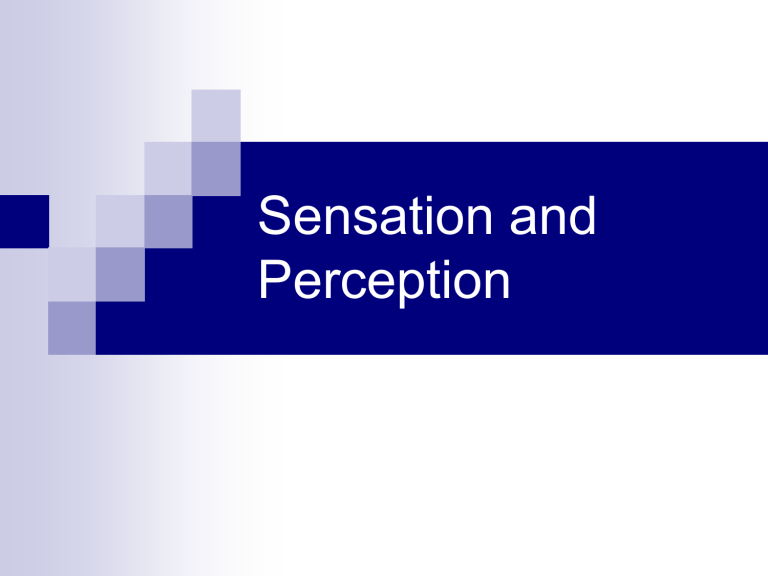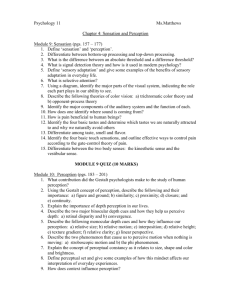Introductory Psychology

Sensation and
Perception
Sensation vs. Perception
Sensation
Energy receptor cell transduction
Perception
Interpretation of sensation
Sensory Thresholds
Absolute threshold
Difference threshold
Just noticeable difference
Weber’s law
How sensitive are you?
Sensory adaptation
Visual System
Psychologists have studied vision more than any other sense
The Visual System
Light enters the eye through the cornea
The Visual System
Light enters the eye through the cornea
Neural impulses are created in the retina by receptor cells
rods and cones
Cells in the Retina
Trichromatic Theory
Trichromatic Theory
There are three types of cones:
red, green, and blue
Perceived colors are result from differing amount of light absorbed by the three types of cones .
Opponent-Process Theory
Color-sensitive ganglion cells are arranged in opposing cells
Red-green, yellow-blue, black-white
Activation of one cone inhibits another
May explain some kinds of afterimages
Gestalt Psychology
Gestalt psychologists investigated the principles that guide how we create a coherent perceptual experience
Figure-Ground Distinction
Proximity
Proximity – Take 1
Proximity – Take 2
Similarity
Continuation
Closure
Good Figure
Common Fate
Depth Perception
Binocular Cues
Retinal disparity
Depth Perception
Binocular Cues
Depth Perception
Monocular Cues
Object size/Size constancy
Depth Perception
Linear Perspective
Depth Perception
Relative size and linear perspective
Depth Perception
Detail
Interposition
Depth Perception
Texture Gradient
Shadows
Depth Perception
Depth Perception
Aerial
Perspective
Depth Perception
Motion Parallax
Demonstration
Hearing
Sound…
How do we hear?
Hearing Loss
Conductive Hearing Loss
Nerve Deafness
Pitch Perception
Place Theory
Frequency Theory
Volley principal
Auditory Perception
Localizing Sound
Smell
Taste
Receptor cells are in buds on tip, sides, and back of the tongue.
Kinesthetic and Vestibular Senses
Kinesthetic sense
Muscle movement, changes in posture, and strain on muscles and joints
Stretch receptors and golgi tendon organs
Vestibular sense
Equilibrium & body position in space
Semicircular canals of inner ear & vestibular sacs
The Skin Senses
Receptors in the skin
Touch, Pressure, Temperature,
Pain
Information goes to brain through two routes
Through medulla and thalamus to sensory cortex, or
From thalamus to reticular formation.
Pain
Gate-control theory
A gate in spinal cord permits, prevents pain signals from passing
Other impulses can overwhelm
Perception can influence pain






